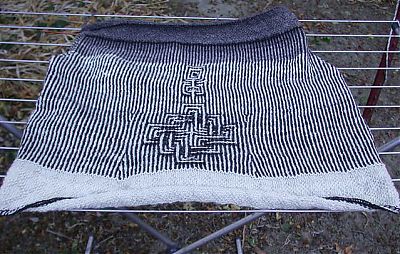2 December 12
Fibershed
A couple of weeks ago I went with a couple of friends to the Fibershed Symposium in Point Reyes Station. This is a group of people led by Rebecca Burgess (brilliant author of Harvesting Color and passionate advocate of locally-grown and produced textiles) who aim to transform the amazing resources we have in Northern California into a self-sustaining industry so the wool that is grown here can be used rather than thrown away (or shipped to China to be processed there and shipped back).
We heard from local growers (of whom one was Robin Lynde of Meridian Jacobs, where I am a Farm Club member) about the joys and challenges of raising fiber animals in our region. One of the shepherds has Marenna dogs to guard the sheep against coyotes; vet bills for her dogs have to factor into the cost of raising the wool. You have to factor in the cost of irrigating pasture in a region where there is little to no rainfall from April to October. (Pasture health is a prime concern for sustainable farmers.) You have to factor in vet bills for the sheep as they always, as Pratchett’s Granny Aching says, look “for new ways to die.”
We also heard from sheep shearers, whose perspective on fleece quality is not often heard, and from two people with crazy exciting ideas for starting fiber/textile processing plants here in Northern California.
 Rebecca spent a year wearing clothes, including underwear, that had been grown and produced within 150 miles of her home in Petaluma. This is a tall order but taking a cue from her, I’ve designed, spun, and am knitting a vest that I hope will replace my polartec one. It needs to be tough; it needs a zipper up front and on two side pockets; it needs to be able to handle my keys in the pocket; it needs to be wind-and-rain-resistant.
Rebecca spent a year wearing clothes, including underwear, that had been grown and produced within 150 miles of her home in Petaluma. This is a tall order but taking a cue from her, I’ve designed, spun, and am knitting a vest that I hope will replace my polartec one. It needs to be tough; it needs a zipper up front and on two side pockets; it needs to be able to handle my keys in the pocket; it needs to be wind-and-rain-resistant.
I discovered the Swedish technique of twined knitting when I first got back into knitting after a 25-year absence, and it’s the reason I learned how to spin, since yarn for this technique is typically spun and plied in the opposite directions of most commercial yarns. The fabric is taught but not as much as woven, making it ideal for this kind of outer garment; it doesn’t shrink or felt when wet. I also wanted to showcase the beauty of the multi-colored Jacob sheep.
 I spun the yarn from the fleece of a sheep named Summer but ran out close to the collar. (Note to self: you don’t really need to do 4-ply sport weight…) The good news about sheep though is that they’re always growing more.
I spun the yarn from the fleece of a sheep named Summer but ran out close to the collar. (Note to self: you don’t really need to do 4-ply sport weight…) The good news about sheep though is that they’re always growing more.
 Here are some locks from Summer’s fleece, shorn in early November; her dark spots have lightened over the two years but it’s lovely, soft, and a joy to spin. These locks were soaked in rainwater, then spent 3 days in a fermented suint vat, then rinsed in rainwater. No heat/energy required…
Here are some locks from Summer’s fleece, shorn in early November; her dark spots have lightened over the two years but it’s lovely, soft, and a joy to spin. These locks were soaked in rainwater, then spent 3 days in a fermented suint vat, then rinsed in rainwater. No heat/energy required…
Finally, here I am with Summer right after she was shorn. There’s something very satisfying about making a garment from an animal you know personally…

Previous: A Trip to New York Next: An Adventure in Felting
